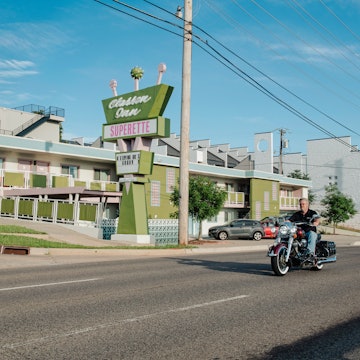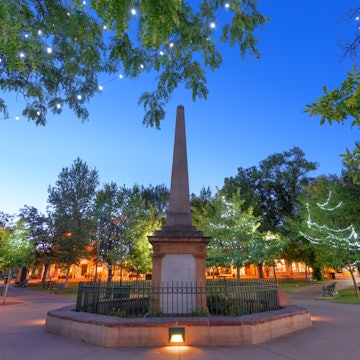
Experience food, art and history in Santa Fe's neighborhoods

Aug 26, 2021 • 5 min read

Get to the heart of Santa Fe's culture and culinary scene in the city's downtown Historic District © Sean Pavone / Shutterstock
At the foothills of the Sangre de Cristo Mountains, Santa Fe is an ancient and colorful place – the biggest little city in the Southwest.
For anyone visiting Santa Fe, it’s easy to get worn out by the high elevation, intense sun and abundance of things to see, taste and experience in a small radius. Rather than get sensory overload, take your time and immerse yourself in the history, art and culture of one area at a time.
Here are the best neighborhoods to explore on your visit to Santa Fe.

Santa Fe Plaza
Best for getting to the heart of Santa Fe
History is anything but passive in Santa Fe. Its juxtaposition of antiquity and modernism creates a visceral effect that some have found difficult to leave behind when the trip is done.
Santa Fe, called Oga Po’geh Owingeh in Tewa by the area’s original inhabitants, translates to Holy Faith in Spanish. Home to over 250 galleries and award-winning chefs, Santa Fe is the state’s beating heart of artistic and culinary adventures. Start your travels at Santa Fe Plaza, the center of it all. Distinct with contemporary and traditional art of every kind, down-home New Mexico cuisine and fine dining alike, and top-notch hospitality, the Plaza is also a historic reminder of Spanish conquest, Pueblo revolt and the eventual colonization of Northern New Mexico.
You will find the oldest house in the United States sharing an adobe wall with the best pizza joint in town. You’ll enter the luxury Inn at Loretto and in doing so, find the historic Loretto Chapel where stands a miraculous spiral staircase said to have been built by the reappearance of St. Joesph himself in 1878. And upon entering the grounds you will pass by sculptures by Cochiti Pueblo artist Virgil Ortiz, who draws his inspiration from the Pueblo Revolt of 1680.
As they say, all roads lead to the Plaza. You can get anywhere in Santa Fe from the plaza in no time at all. There are at least a dozen luxury hotels a stone’s throw from the Plaza making this the ideal place to make one’s Santa Fe vacation headquarters.

Railyard Arts District
Best for partying like a local
The Railyard Arts District is a newly renovated area five minutes southwest of the Plaza stocked with contemporary art galleries, a cinema, local breweries, cafes, fusion dining and beyond for a bite or a drink, a variety of shops and a packed calendar of outdoor events, concerts, art and farmers markets.
What was once ten acres of coal and fuel storage for the railroad is now one of the most vibrant and youthful parts of town.
The best time to visit Santa Fe
Agua Fria Village
Best for discovering the complex history of the Southwest
Located five miles southwest of the Santa Fe Plaza, Agua Fria Village – called Ca-Tee-Ka by the Tewa – represents a more down-to-earth side of Santa Fe. Whereas Santa Fe, full name "La Villa Real de la Santa Fé de San Francisco de Asís" – the Royal Town of the Holy Faith of Saint Francis of Assisi – has always been a little bougie, Agua Fria Village was a community of humble, Spanish speaking farmers who worked the land until the acequias (irrigation ditches) were cut off to them in 1945, destroying their way of life.
Today it recalls that history through its architecture, which more closely resembles what a typical New Mexico community looks like, as well as in the energy of the place itself. Almost like the answer to Acequia Madre Street, the farther south you venture on Agua Fria Street, the more you will find original Spanish families who represent their cultural pride through creative expression that can be appreciated from the street. Murals, lowriders and ornate rod iron fences with Spanish family crests can all be found down Agua Fria to give you a rounded experience of what it means to be New Mexican.

Canyon Road
Best for art enthusiasts
There are over 100 galleries on Canyon Road alone. This 6-mile long road is a legendary destination for artists and art enthusiasts. Located in what were once homes, the galleries of Canyon Road are all very homey – giving visitors a sense of the old adobe architecture that built the city – and are always very welcoming to their guests regardless if you are a buyer or an admirer.
Many of the galleries also feature lush gardens, most open to the public. Take a stroll down the charming street during the changing of seasons when the trees begin to blossom and bulbs burst into bloom, or during the height of summer when the flowers are at their peak, creating an oasis in the desert. In the winter holiday season, the district glows with a fairytale shimmer as rows of paper bags are illuminated with a candle in each. This quirky New Mexico custom began as small bonfires and evolved into paper bags in the ‘30s, called luminarias to the south of Santa Fe and farolitos in Santa Fe and to the north. Today many use electric versions that can be safely lined along roofs, creating epic scenes at night.
‘Red or green?’ New Mexico's most mouth-watering dishes
Acequia Madre
Best for shady streets and adobe homes
To appreciate this neighborhood one must go down memory lane. Acequia Madre is a street that runs parallel to Canyon Road, alongside the Acequia Madre. Hundred-year-old orchards and grazing pastures depend on the life-sustaining water the irrigation system delivers. This acequia, built by the Spanish over 300 years ago, has only stopped its flow twice, once during the Pueblo Revolt when the water to it was cut off, forcing the Spanish to evacuate, and again when the Spanish re-conquered the city.
What were once the homesites of old Spanish families, then the hangouts for the counterculture in the ‘60s, are now some of the most expensive haciendas in Santa Fe. Just like driving the Garden District in New Orleans, a cruise along Acequia Madre is a looky-loo’s paradise. Follow the meandering road into a quiet world of postcard-perfect homes, all of which could easily be the set of the next great Western film.
Let us not forget to mention the local tale of La Llarona, the wailing woman who wanders ditch banks looking for her lost children. This iconic ghost of New Mexico, whom children are warned about lest they wander too close to the water and get snatched up, is but one of the spirits you might find along this waterway.















